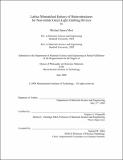| dc.contributor.advisor | Eugene A. Fitzgerald. | en_US |
| dc.contributor.author | Mori, Michael James | en_US |
| dc.contributor.other | Massachusetts Institute of Technology. Dept. of Materials Science and Engineering. | en_US |
| dc.date.accessioned | 2009-01-26T22:00:49Z | |
| dc.date.available | 2009-01-26T22:00:49Z | |
| dc.date.copyright | 2008 | en_US |
| dc.date.issued | 2008 | en_US |
| dc.identifier.uri | http://hdl.handle.net/1721.1/44198 | |
| dc.description | Thesis (Ph. D.)--Massachusetts Institute of Technology, Dept. of Materials Science and Engineering, 2008. | en_US |
| dc.description | This electronic version was submitted by the student author. The certified thesis is available in the Institute Archives and Special Collections. | en_US |
| dc.description | Includes bibliographical references (p. 161-165). | en_US |
| dc.description.abstract | In this project, we implement modern metal organic chemical vapor deposition (MOCVD) technology to fabricate monolithic platforms which integrate traditionally incompatible materials with the ultimate goal of achieving high brightness green to amber light emitting diodes (LEDs) and laser diodes (LDs). Unconventional compositions of aluminum indium gallium phosphide (AlInGaP), with lattice constants less than that of GaAs, offer improved electrical and optical characteristics over commonly used GaAsmatched material. Also, integration of optical III-V material on the CMOS platform has long been a technological goal, and these compositions of AlInGaP are amenable to monolithic integration on the (100) Si platform. In this thesis, we pioneer technology to integrate high quality, novel AlInGaP alloys on III-V substrates (and elsewhere, this technology is successfully extended for III-V integration on (100) Si). We first focus on creating a virtual substrate upon which any lattice constant intermediate to GaAs and GaP is available. Large amounts of lattice mismatch are ultimately relaxed through incremental introduction of strain in compositionally graded epitaxial layers, thus breaking the typical lattice-matched constraint of semiconductor systems. Tensile relaxed gallium arsenide phosphide (GaAsP) graded layers yield virtual substrates with extremely low threading defect densities ([rho]t=104cm-2), while extremely thin, 1.3[mu]m compressively graded GaAsP buffers also yield low thread densities ([rho]t=105cm-2). The lack of phase separation defects along with the atomically smooth nature of the tensile films leads to suppression of dislocation nucleation and efficient dislocation glide which together facilitate complete strain relaxation with minimal escalation of [rho]t. | en_US |
| dc.description.abstract | (cont.) Next we present microstructural studies of AlInGaP lattice-matched to these virtual substrates. Atomic mechanisms of formation of defects including CuPt-B atomic order, phase separation defects and GaAsP surface undulation are understood. A competitive two-step model which describes their creation at the growth surface and subsequent destruction in a high diffusivity subsurface layer makes possible intuitive adjustment of MOCVD growth parameters for defect-free AlInGaP heterostructures. Finally, fabrication of LEDs is discussed. As predictions show, electroluminescence color ranges from green (570nm) to amber (606nm). These structures hold promise for LDs and high efficiency LEDs at wavelengths as low as 550nm. | en_US |
| dc.description.statementofresponsibility | by Michael James Mori. | en_US |
| dc.format.extent | 165 p. | en_US |
| dc.language.iso | eng | en_US |
| dc.publisher | Massachusetts Institute of Technology | en_US |
| dc.rights | M.I.T. theses are protected by
copyright. They may be viewed from this source for any purpose, but
reproduction or distribution in any format is prohibited without written
permission. See provided URL for inquiries about permission. | en_US |
| dc.rights.uri | http://dspace.mit.edu/handle/1721.1/7582 | en_US |
| dc.subject | Materials Science and Engineering. | en_US |
| dc.title | Lattice mismatched epitaxy of heterostructures for non-nitride green light emitting devices | en_US |
| dc.type | Thesis | en_US |
| dc.description.degree | Ph.D. | en_US |
| dc.contributor.department | Massachusetts Institute of Technology. Department of Materials Science and Engineering | |
| dc.identifier.oclc | 269328751 | en_US |
